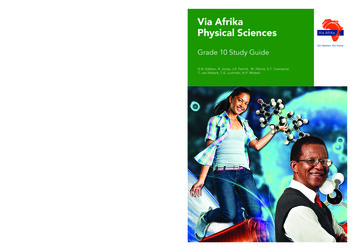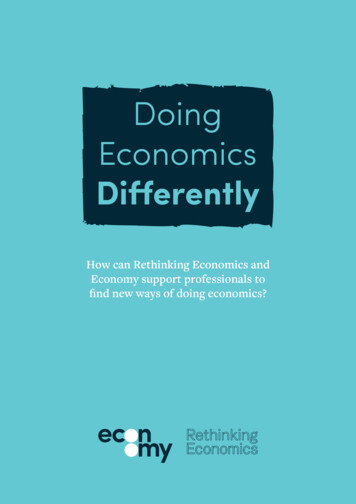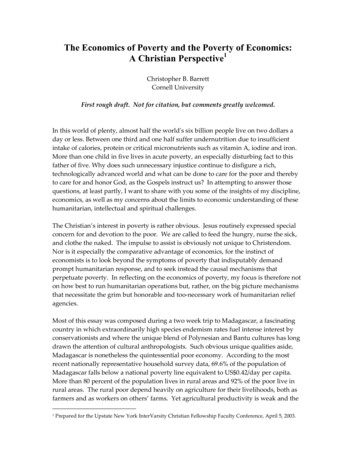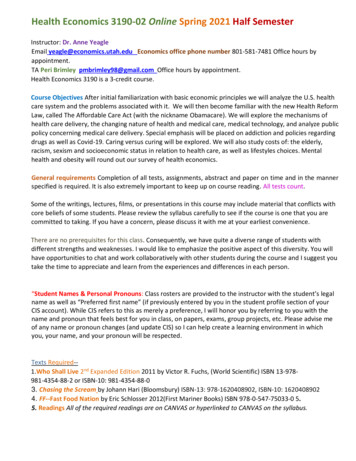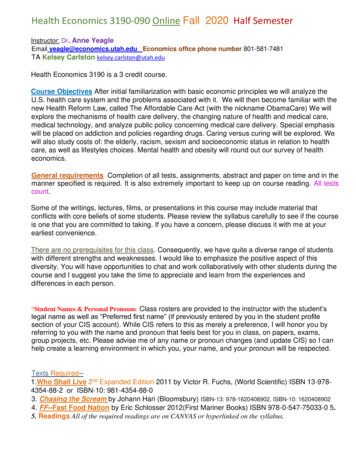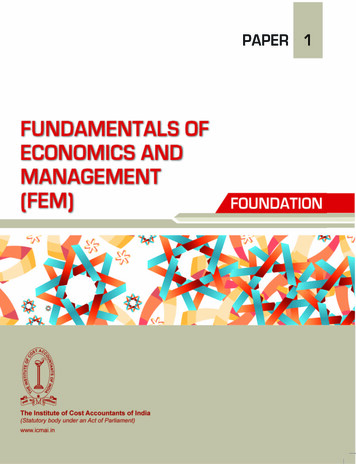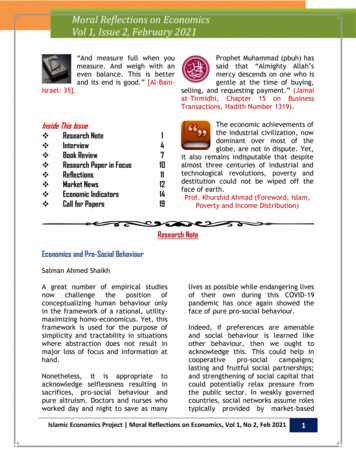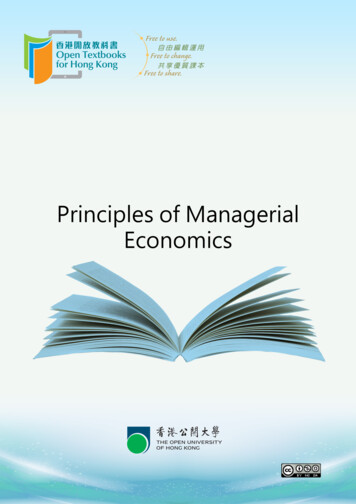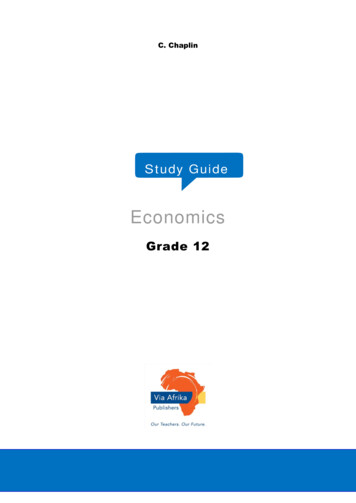
Transcription
C. ChaplinS t u d y G ui deEconomicsGrade 12
ContentsTerm 1 . 11 Topic Circular Flow . 12 Business Cycles . 133 Public Sector . 20Term 2 . 381 Economic systems: protection and free trade (globalisation) . 382 Dynamics of markets: perfect markets . 443 Dynamics of markets: imperfect markets . 594 Dynamics of markets: market failures.67Term 3 . 721 Economic growth and development) . 722 Economic growth and development: industrial development policies . 783 Economics: basic concepts and quantitative elements (economic and socialperformance indicators). .844 Economic issues of the day: inflation.895 Tourism and economic redress: environmental sustainability . .966 Basic economic problem: environmental sustainability.103Answers term 1-3. . .107End-of-year examination paper microeconomics.143Final examination paper macroeconomics.148Memo microeconomics.155Memo macroeconomics.162
1TERMTerm1Topic 1 Circular flowOverviewThis topic discusses the open economy circular flow model and the various markets thatfacilitate economic activities. It also deals with national accounts aggregates andconversions, and the multiplier effect in the economy.In this topic, you will learn about: The open economy circular flow modelThe marketsNational account aggregates and conversionsThe multiplierThe circular flow model The participantsThe flowsNational account aggregates and conversions Basic pricesFactor costMarket costGNIGDP Via Afrika Publishers EconomicsThe markets Goods market Factor market Financial market Foreign exchange market Flows through different marketsThe Multiplier Meaning of the multiplier The multiplier process in a two-sectormodel The multiplier effect in a graphical form The multiplier process in the three andfour sector models1
TERM1Unit 1 The open economy circular flow modelIntroductionThe circular flow model shows us how the economy functions by illustrating the relationship in theeconomy between production, income and spending. As consumers we have to make choices asthere are scarce resources to satisfy our unlimited needs and wants.Macroeconomics explains how the economy functions as a whole while microeconomics explainshow particular and specific elements of the economy operate, for example importers, consumers,etc.1. The complete diagramThe circular flow model of an open economy shows the workings of an economy that is open toforeign trade. South Africa has an open economy because we trade with other countries.1.1 ParticipantsThe flows of production, income and expenditure are influenced by four participants: households(consumers), firms (business enterprises), government (public sector) and the foreign sector.1.1.1 HouseholdsIn economics a household is any number of people that live together and make joint economicdecisions. A household can consist of one person or a number of people. They sell their factors ofproduction (productive resources) to the factor market. The factors of production are bought byfirms to produce goods and services. Households spend the income they earn to buy goods andservices from firms. We call spending on goods and services consumption expenditure (C).Households do not spend all their money on goods and services. They keep their savings (S) withfinancial institutions such as banks and insurance companies. They also pay taxes (T) to thegovernment in various forms such as value-added tax or income tax.1.1.2 FirmsFirms produce the goods and services that are bought and consumed by other participants such ashouseholds. In order to do this they buy factors of production from households. In return for thegoods and services they produce firms earn revenue.1.1.3 GovernmentThe government buys factors of production from the factor market to produce goods and servicesfor the public. In exchange for public goods and services, firms and households pay taxesto the government.1.1.4 Foreign sector Via Afrika Publishers Economics2
TERM1The foreign sector consists of imports and exports of goods and services. Importers buy goods andservices from other countries, whilst exporters sell goods and services to other countries.1.2 Real flows and money flowsThe circular flow model shows us the real flow and the money flow. The flow of goods and servicesbetween the various participants is called real flow. Examples include flows of: Factors of production from households to firmsGoods and services from firms and the foreign sector to households.The flow of money earned and spent between the various participants is calledthe money flow. Examples include flows of: Payment for factors of production in the form of rent, profit, wages andsalaries and interest from firms to householdsPayment for goods and services by government.It is important to remember that for every money flow there is a real flow and that real flows andmoney flows move in opposite directions. Via Afrika Publishers Economics3
TERM11.3 Leakages and injectionsThere are always interruptions in both the real flow and the money flow which are caused whenthere are injections into the economy or leakages from it.1.3.1 LeakagesA leakage happens when money leaves the circular flow and decreases the amount of money incirculation in the economy.There are three types of leakages: Savings (S): Some households do not spend all their money and savesome of it. This money goes to a financial institution, for example, a bank. Taxes (T): Households and firms pay taxes to the government, for example valueadded tax (VAT) and income tax. The amount of tax decreases the disposableincome of households that therefore spend less on goods and services. Imports (M): This represents spending on foreign goods and services.Money is withdrawn from circulation and goes to foreign markets to payfor the imports.1.3.2 InjectionsAn injection happens when money enters the circular flow and increases the amount of money incirculation in the economy. This can happen in three ways: Government spending (G): The government spends money on goods andservices to provide economic and social services and infrastructure, forexample hospitals, schools, dams and roads. An increase in governmentspending increases the spending on goods and services and the flow ofspending, production and income increases. Investment (I): This is the money spent by firms to buy capital goods.They obtain loans from financial institutions to buy plant, equipmentand property. They can also use this money to build up inventories andto buy intermediate goods or raw materials. When there is an increase ininvestments, the flow of spending, production and income increases. Exports (X): Money flows into the circular flow from other countries.As more goods and services are sold to foreign countries, more foreignexchange is earned. This will increase income, spending and production. Via Afrika Publishers Economics4
TERM11.4 Model equationsIf leakages (L) and injections (J) are equal, income will be constant.This is expressed as follows:L S T M G I XProduction, income and expenditure can be expressed as follows:Production income expenditure.P Y EGross Domestic Expenditure (GDE) is calculated as follows:Final consumption expenditure by households (C) Gross capital formation(I) Final consumption expenditure by general government (G).GDE C I G, where C, I and G include imports and exclude exports.GDP at market prices (mp) GDE (X – M) C I G (X – M) Via Afrika Publishers Economics5
TERM1Unit 2 The markets1. Goods marketThe goods market provides goods and services in exchange for money. Households, government,firms and the foreign sector buy goods and services offered in the goods market. Although there aremany different markets in macroeconomics we group all these markets together and consider thegoods market as a single market. We call this aggregation.2. Factor marketThe factors of production are bought and sold in the factor market. The factors of production areexchanged for money.3. Financial marketFinancial institutions act as agents to facilitate the lending and borrowing of capital. The financialmarket is divided into the money market and the capital market. The money market is the market for short-term savings and loans.Short-term is defined as lasting less than a year. The South African Reserve Bank is a majorinstitution in the money market. The capital market is the market for long-term savings and loans. Long-term investmentsand mortgage bonds are examples of capital market activities. The Johannesburg SecuritiesExchange is the major institution in the capital market.4. Foreign exchange marketForeign trade requires foreign currencies and these currencies can only be exchanged in the foreignexchange market. If you import goods from the United Kingdom you will have to pay for them inpounds and if you export goods to the USA you will be paid for them in dollars. The foreign exchangemarket determines the rate at which the foreign currencies are traded. This is called the exchangerate.5. Flows through different marketsFactors of production flow through the factor markets from households to firms to produce goodsand services (real flow). Goods and services flow from firms through the goods market tohouseholds (real flow). Savings flow from households to financial markets (money flow) and thesesavings are made available to firms in the form of loans to further production by buying capitalgoods (money flow). The flow of exports to other countries through the foreign exchange markets(real flow) and the income received for exports through the foreign exchange market (money flow). Via Afrika Publishers Economics6
TERMUnit 31National account aggregates and conversions1. National accounts aggregatesWe can identify the national accounts as follows: Production refers to the gross domestic product (GDP(P)) as gross valueadded. Expenditure refers to the gross domestic expenditure (GDP(E)). Income refers to the gross domestic income (GDP(I)).1.1 Deriving the national accounts aggregatesIn South Africa our national accounts are prepared by the South African Reserve Bank.1.1.1 ProductionThis is the GDP (P) which is the sum of all production units produced by the primary, secondary andtertiary sectors in the economy. GDP (P) is the gross value added of total output less the value of theinput utilised in the production process.1.1.2 ExpenditureExpenditure on GDP is the total expenditure on final goods and services produced within theboundaries of a country. It is calculated by adding all expenditures of the four participants in theeconomy (households, government, firms and the foreign sector).1.1.3 IncomeEvery factor of production earns income when goods and services are produced. Thereforethe total income earned must be equal to the total value of production. Gross DomesticIncome (GDI) is the sum of all income earned by resident individuals or firms in theproduction of goods and services.1.2 National account conversionsFour sets of prices are used in the national accounts: basic prices (BP), factor cost (FC), market prices(MP) and net or gross figures.Basic prices are the initial prices in the production of final goods and services, before considering anytaxes and subsidies on products and production.Factor cost (FC) is used when GDP is calculated using the income method. The factor pricerepresents the price received by each factor of production – rent, wages and salaries, interest andprofit.Market prices (MP) are used when GDP is calculated using the expenditure method. These are pricesthat consumers pay for goods and services. Market prices include taxes and subsidies. Via Afrika Publishers Economics7
TERM1The net figures used in national accounts have already had an amount of money subtracted fromthem. A net amount reflects the total after the provision for depreciation has been deducted.National figures give information about the economic activities of the permanent residents of acountry.The Gross National Income (GNI) at market prices is calculated as follows:GNI GDP (MP) primary income from the rest of the world – primary income to the rest of theworld.Domestic figures refer to all economic activities that occur within the boundaries of a country.GDP is expressed in both nominal and real figures. Nominal figures refer to GDP figures that have notyet taken into account changes in price levels while real figures have taken these changes intoaccount.Unit 4 The multiplier1. Meaning of the term multiplierAn increase in the level of spending in the country results in higher GDP and a decrease in spendingresults in a decrease in GDP. We learned in the previous Unit that the components of GDP are C G I (X – M). Therefore, an increase in any one of these components, say investment, will increasereal GDP. However, the change in output (real GDP) and income will be much greater than the initialchange in investment. This result is called the multiplier effect.The multiplier effect is the extent of the change in real output and income that is caused by a changein aggregate demand. The size of the change in output (real GDP) and income is determined by themultiplier.2. The multiplier process in a two-sector modelConsumers either spend their money or save it. The proportion spent shows the marginal propensityto consume (MPC) and the proportion saved shows the marginal propensity to save (MPS). The MPCtells us how much of their new income a person is likely to consume.The formula for calculating MPC is:MPC ΔCΔYwhere: C is the change in consumption. Y is the change in income.The formula for calculating MPS is: Via Afrika Publishers Economics8
TERMMPS 1ΔSΔYwhere: S is the change in savings. Y is the change in income.2.1 Calculating the multiplierWe can use the multiplier as a better way of calculating the change in real GDP instead of calculatingsuccessive rounds of spending. To determine the value of the multiplier, we need to know the valueof MPC. Remember the formula for MPC is C Y.The formula for the multiplier is:k 1(1 – MPC)Where k represents the multiplier.2.2 The size of the multiplier effectHow big or small will the eventual change in income be if money is injected into the economy? Theanswer to this question depends on the size of the MPC. The bigger the multiplier effect and thesmaller the MPC, the smaller the multiplier effect. In other words, the multiplier effect has a directrelationship to the MPC.3. The multiplier process in the three and four sector modelsThe three-sector model includes government. When we calculate the multiplier, we must includethe effect of taxation as a leakage.Our formula will then be:k 1(MPS MRT)Where: MRT is the marginal rate of taxation.In the four-sector model we include the foreign sector. The multiplier is calculated by including themarginal propensity to import, MPM. The formula for a four-sector economy is:k 1(MPS MRT MPM)Where: MPM is the marginal propensity to import.4. The multiplier in graphical formThe multiplier can also be shown graphically Via Afrika Publishers Economics9
TERM1Questions1. List the four participants that influence the flows of production, income and expenditure.(8)2. Explain what is meant by the term household in economics.(4)3. Explain what you understand by the term leakage in economics.(44.Explain what you understand by the term injection in economics.(4)5. Give a formula for calculating the Gross Domestic Expenditure of a country.(4)6. Explain what is meant by the economic term aggregation?(4)7. Name the two parts of the financial market?.(4)8. Why is the foreign exchange market important for importers and exporters?(4)9. Study the following table and answer the questions: Via Afrika Publishers Economics10
TERM12009R millionsCompensation of employees1 077 833Net operating surplus731 204Consumption of fixed capital332 584Gross value added at factor costOther taxes on productionLess: Other subsidies onproductionGross value added at basicpricesTaxes on productsLess: Subsidies on products2141 62142 10192102 174 512238 55714 914Gross domestic product atmarket prices2 398 155Final consumption expenditureby households1 460 911Final consumption expenditureby general government502 492Gross capital formation470 963Residual item-15 095Gross domestic expenditure2 419 271Exports of goods and services657 192Less: Imports of goods andservices678 308Expenditure on gross domesticproduct2 398 155(GDP at market prices)Primary income from the rest of Via Afrika Publishers Economics34 07511
1TERMthe world.Less: Primary income to the restof the world .87 593Gross national income at marketprices2 344 637(Source: South African Reserve Bank, Quarterly Bulletin, March 2012)a.What is the difference between gross domestic expenditure and expenditure on gross domesticproduct. (4)b. What is meant by gross capital formation. (2)c. In 2009 households received R for the provision of labour to the economy. (1)d. If factor prices are used to calculate the gross domestic product then the gross domestic productwas equal to R in 2009. (1)e. In 2009 the subsidies received by firms on production were R . (1)f. In 2009 the taxes on products, were R . (1)g. In 2009 consumption spending by households was R . (1)h. In 2009 the primary income South Africans earned from the rest of the world was (more,less) than the primary income we paid to the rest of the world. (1)i) Explain why the expenditure on gross domestic product in 2009 was less than the grossdomestic expenditure. (2)(14)10. Indicate and explain whether the following variables are leakages or injections.VariableLeakage nt spendingImportsExports(18) Via Afrika Publishers Economics12
1TERMTopic 2 Business cyclesOverviewThis topic discusses business cycles, reasons for their occuring and measures the government cantake to try and even out fluctuations in business cycles.In this topic, you will learn about: The composition and features of business cyclesExplanationsGovernment policyThe new economic paradigm (smoothing of cycles)Features underpinning forecasting with regard to business cycles.Composition and features of business cycles Expansion and contractionPeaks, downswings, troughs & upturnsExogenous and endogenous factorsChanges in business cyclesGovernment policy Fiscal and Monetary policiesDemand and supply side actionsForecastingEconomic indicators-leading-lagging- coincidentUnit 1 The composition and features of business cycles1. The nature of business cyclesThe level of economic activity in a country changes all the time. A period of high activity is called anexpansion (or upswing) and a period of low activity is called a contraction (or downswing). Theseperiods of expansion and contraction recur in a cyclical fashion. Periods of expansion and Via Afrika Publishers Economics13
TERM1contraction in the economy are captured by a graph called the business cycle. The business cycledepicts fluctuations which occur in the economic activity of a country.1.1 The expansion phaseThis phase is characterised by growth in real GDP and income. It consists of two phases – recoveryand prosperity. During the prosperity phase there is an increase in real GDP, income andemployment. Businesses make high profits and this attracts other businesses to enter the market. Asmore businesses open, more factors of production are employed. The increase in income causes anincrease in aggregate demand which in turn forces producers to increase output. This causes anincrease in investment spending as producers expand their businesses and buy more inventories.Expansion ends when it reaches the maximum point of the business cycle – the peak. The peak isthe upper-turning point where the economy has reached its full capacity. It cannot grow beyond thispoint. This is also a point of full employment where factors of production have been fully utilised.This point is characterised by high rates of inflation.1.2 The contraction phaseThis phase is characterised by a period of gradual decline in economic activity. There is a decrease inaggregate demand that forces a decrease in output. The decrease in sales leads employers to reduceemployment and income decreases. There is a downward spiral of real GDP, employment, income,and in the standard of living. The contraction period consists of two phases: recession anddepression. A recession follows immediately after the peak. It is a phase where economic activitystarts to slow down. It is also called the economic downturn. It occurs when there is a continuousdecrease in economic activity for a period of six consecutive months (or two quarters). If a recessioncontinues for more than two quarters, the economy enters a depression phase. Via Afrika Publishers Economics14
TERM1Unit 2 Explanations of the business cycles1. IntroductionBusiness cycles can be caused by factors outside the market economy (called exogenous factors) orbusiness cycles are an integral part of the market economy (called endogenous factors).2. Causes of business cycles2.1 Exogenous factorsClassical economists of the 19th century believed that the market economy was always stable andthat any fluctuations were caused by outside factors - exogenous factors.Examples of exogenous factors include: Natural disastersPolitical reasonsPsychological reasonsChanges in weather patternsTechnological innovationsShifts in consumer tastes and preferences.2.2 Endogenous factorsThe Keynesian school of thought believes that the market economy is by its very nature unstable andis characterised by periodic waves of high and low economic activity. They believe that businesscycles are an integral part of the market system itself. They believe that business cycles are causedby endogenous factors that emanate from the system itself and that since the market is not able tocorrect this it is the governments duty to intervene.Exogenous factors include: Changes in investment may put the economy into a growth or declining phaseChanges in aggregate demandChanges in aggregate supplyTechnological changes and innovationsMonetary policy changes.3. Changes in business cyclesJoseph Schumpeter, the Austrian economist, documented a list of different kinds of business cyclesand named them after the people who discovered them. He grouped them into short-, medium- andlong-term business cycles. The Kitchin Cycle: discovered by the British economist Joseph Kitchin. It is the shortestbusiness cycle and lasts for 3–5 years and is caused by changes in inventory levels.The Jugler Cycle: discovered by the French economist Clement Juglar, it lasts from 7 to 11years and is caused by changes in investment in equipment and machinery. Via Afrika Publishers Economics15
TERM 1Kuznets Cycle: discovered by Simon Kuznets, a Nobel laureate. It lasts from 15 to 20 yearsand is caused by changes in infrastructural investment in housing and building construction.Kondratieff Cycle: is the longest cycle which lasts for 45 to 60 years. It was discovered byRussian economist, Nikolai Kondratieff. It consists of six Juglar cycles and is caused bytechnological changes and innovations.Unit 3 Government policy1. IntroductionAccording to J.M. Keynes, the market economy cannot survive on its own and it requiresgovernment intervention to stabalize the business cycles. To counter the problems of business cyclesgovernments can use fiscal or monetary policies.2. Monetary policyThe South African Reserve Bank implements monetary policy. The Governor of the Reserve Bank, inconsultation with the Minister of Finance, decides on the best policy to apply. There are twoinstruments of monetary policy: interest rates and money supply.2.1 Interest ratesThe Reserve Bank must try and keep inflation under control at all times. During a period ofexpansion, there is an increase in aggregate demand for both local and imported goods. The suddenincrease in demand causes an increase in the prices of goods and services. The best monetary policyin this situation is to increase interest rates which reduces the demand and therefore slows downthe increase in price levels.2.2 Money supplyThe Reserve Bank uses its supply of security instruments such as government bonds and treasurybills to control money supply. If there is too much money in circulation the SARB sells thesesecurities to banks and other financial institutions. The SARB debits the bank’s account with thevalue of the sale and the bank’s balance with the Reserve Bank is reduced. This reduces the ability ofthe bank to offer credit. The Reserve Bank will use this policy during prosperity to mop up excessmoney in circulation. If there is not enough money in circulation it does the opposite.3. Fiscal policyFiscal policy is used by the South African government to adjust its levels of spending in order tomonitor and influence our economy. Its counterpart is monetary policy which is used by the centralbank to influence a nation’s money supply. These two policies are used in various combinations in aneffort to direct our country’s economic goals.3.1 Taxation Via Afrika Publishers Economics16
TERM1By increasing taxation the government can reduce the amount of money in circulation. By loweringtaxation it can increase the amount of money in circulation.3.2 Government spendingAn increase in government spending will have a multiplier effect in the economy – national incomewill increase by an amount far greater than the actual amount spent. Government must reducepublic expenditure during prosperity when the economy is overheated as an increase in spendingwould only make inflation worse.Unit 4 The new economic paradigm (smoothing of cycles)1. Rationale for the new economic paradigmIt is often difficult for difficult for governments and economists to decide when to implement newpolicy changes. This has prompted them to look for other ways to smooth out the impact of businesscycles. The new economic paradigm offers one solution – the possibility of growth without inflation.The new economic paradigm uses two instruments, namely, demand-side and supply-side policies.2. Demand-side policy The aggregate demand created by households, businesses and the government (C I G) isthe driving force in the economy.A change in aggregate demand will have a direct effect on unemployment and inflation.An increase in aggregate demand forces producers to employ more labour to meet demand.As a result production and income increase but increase in demand puts pressure on thegeneral price level. As a result, inflation increases.When aggregate demand decreases, producers will reduce their production. In reducingproduction, firms will retrench workers and decrease the income of households.The effect is an increase in unemployment and a decrease in inflation.2.1 General price level (inflation)The conclusion of the new economic paradigm is that when the increase in aggregate demand isaccompanied by a simultaneous increase in aggregate supply, economic growth will be achievedwithout an increase in inflation.2.2 UnemploymentAn increase in aggregate demand causes firms to produce more in order to meet demand. Firms willemploy more workers to increase production and will therefore reduce the rate of unemployment. Ahigher employment rate will give households more income and therefore more to spend onconsumption. This, of course, will create inflation. This trade-off between unemployment andinflation was discovered by the economist, A.W. Phillips who developed the Phillips curve (PC).2.3 StagflationStagflation occurs when inflation is accompanied by stagnation in the growth rate and an increase inunemployment. During stagflation there are simultaneous increases in inflation and unemployment. Via Afrika Publishers Economics17
TERM13. Supply-side policySupply-side economics stresses that economic growth depends on the stimulation of aggregatesupply. The most important aspect of economic growth is the allocation and efficient use of thefactors of production, especially labour and capital. Technical or productive efficiency. This occurs where the firm uses itsresources to produce goods and services at the lowest possible cost. Allocative efficiency. Competition increases allocative efficiency because firms that can usetheir resources more efficiently can attract resources away from firms that are less effici
Money is withdrawn from circulation and goes to foreign markets to pay for the imports. . In South Africa our national accounts are prepared by the South African Reserve Bank. 1.1.1 Production This

